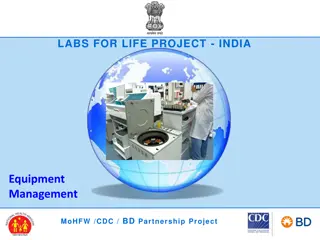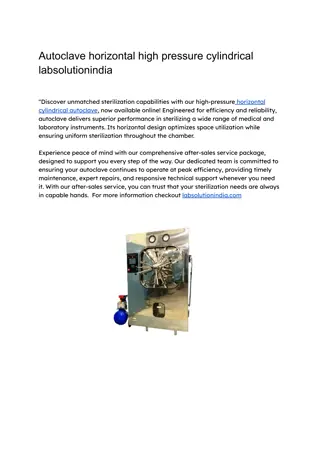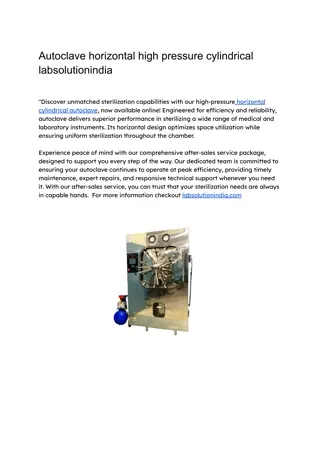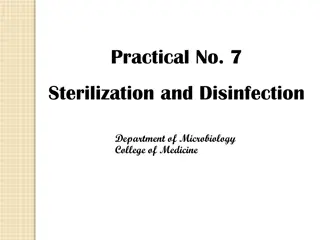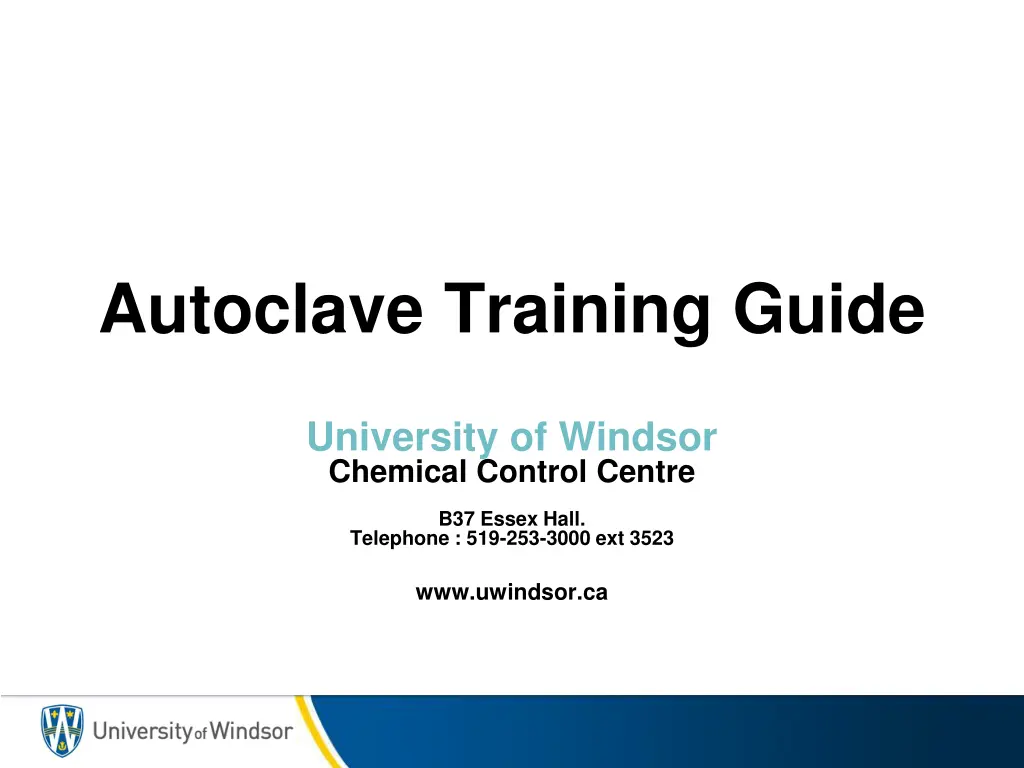
Autoclave Training Guide at University of Windsor Chemical Control Centre B37
Explore the comprehensive autoclave training guide provided by University of Windsor Chemical Control Centre B37. Learn about autoclave overview, hazards, what you can and can't autoclave, along with essential training outlines and safety measures.
Download Presentation

Please find below an Image/Link to download the presentation.
The content on the website is provided AS IS for your information and personal use only. It may not be sold, licensed, or shared on other websites without obtaining consent from the author. If you encounter any issues during the download, it is possible that the publisher has removed the file from their server.
You are allowed to download the files provided on this website for personal or commercial use, subject to the condition that they are used lawfully. All files are the property of their respective owners.
The content on the website is provided AS IS for your information and personal use only. It may not be sold, licensed, or shared on other websites without obtaining consent from the author.
E N D
Presentation Transcript
Autoclave Training Guide University of Windsor Chemical Control Centre B37 Essex Hall. Telephone : 519-253-3000 ext 3523 www.uwindsor.ca
Training Outline Autoclave Overview Hazards What you CAN & CAN T Autoclave How to Autoclave Performance Indicators Quiz
Autoclave Overview Pressurized device that uses heat, steam and pressure to achieve sterilization or decontamination autoclave_lidopen_top_view
Autoclave Overview Typically operated at 121oC (250oF), 15 psi, for 15-45 minutes. Allows the heating of liquids above boiling point. Uses moist heat (steam) to increase efficiency of sterilization. Heat is used to kill microorganisms by coagulation of essential proteins. Autoclaves are expensive instruments! Proper training ensures that they continue to be operational and used properly with minimal issues.
Hazards Tremendous pressure from steam in chamber provides explosive potential. High temperatures creates potential for burns and scalding. Potential exposure to hazardous fumes. Inadequate decontamination allows for the potential of biological hazards to contaminate personnel and the environment.
What you CAN Autoclave Biological waste that can be autoclaved: Microbial stocks and cultures Items contaminated with such waste: petri dishes, pipette tips, pipettes, gloves, paper towel Autoclaving is also used for: Sterilization of items such as; glassware, media, buffers, etc.
What you CANT Autoclave Human/animal anatomical or blood waste Cytotoxic waste Sharps waste Radioactive waste Hazardous chemical waste Material contaminated with toxic, volatile, corrosive, or mutagenic chemicals Material containing solvents, chlorinated compounds (HCl, bleach) Chemicals (such as: phenol, trichloroacetic acid, ether, chloroform, ethidium bromide, glutaraldehyde.)
What you CANT Autoclave SOME PLASTICS Poor Choices: Polystyrene (PS), polyethylene (PE) and high-density polyethylene (HDPE) do not resist heat well. Good Choices: Borosilicate glass (Pyrex) has very low thermal expansion properties and are resistant to breaking due to heat. Polypropylene (PP) and polycarbonate (PC) are heat resistant plastics. Stainless steel is a good heat conductor and thus facilitates sterilization.
Preparing your items PRIMARY CONTAINERS This is the container that comes into direct contact with the contaminated or non- sterilized material or fluid. Do not fill more than 75% of holding capacity. Must NOT be a tightly sealed container must permit heat (steam) penetration. Do not use polystyrene (PS), polyethylene (PE) and high density polyethylene (HDPE) (do not resist heat well).
Preparing your items PRIMARY CONTAINERS (cont d) Loosen screw caps or use self venting caps. Cap open containers with aluminum foil or muslin. If using plastic waste bags, leave a small opening. Small opening Loosen screw caps
Preparing your items SECONDARY CONTAINERS Used to contain any spills The sides of the secondary container must be sufficiently high to contain any spill that may occur Tray MUST be autoclave safe
Preparing your items TEMPERATURE SENSITIVE TAPE Indicates that high temperature has been achieved Does not prove that decontamination or sterilization was successful Assists in tracking autoclaved items Before After
Preparing your items Sign into log book Keeps track of autoclave use for maintenance records Use personal protective equipment Eye protection Heat resistant gloves Lab coat Close-toed shoes
Loading Autoclave biohazardous waste separately Do not overload primary or secondary containers Allow for sufficient steam penetration Do not fill more than 75% to allow expansion without overflow Autoclaved (regular) Unautoclaved Autoclaved (due to being compressed & sealed)
Autoclave Cycle Username and password are lab specific. Do not use the username and password of another lab. Do not give out the username and password to non-trained personnel. Charging autoclave takes 10 minutes be patient. Avoid aborting the cycle it will take 10 minutes to go through all the cycle steps. If you forget to place an item in the load: just add the item to the next load to avoid tying up the autoclave.
Choosing a Cycle The type of cycle depends on what is being autoclaved: Liquid (L) SLOW EXHAUST Controlled vacuum exhaust For autoclaving liquids Prevents liquids from boiling over FAST EXHAUST Passive exhaust Dry goods (i.e. glass/plastic ware and waste) Gravity (G) and Waste (W)
Unloading Use PPE. Always use heat protective gloves. Wait for autoclave to state END CYCLE before opening door. When opening the door, stand away to avoid any residual heat and steam.
Unloading Unmark biohazard signs from waste bags/boxes. Dispose of waste in proper bin or location. Please put back heat resistant gloves for other users. Keep autoclave doors shut when not in use.
Autoclave Performance Indicators How to know if autoclave is functioning correctly: Physical Annual testing by certified technician Pressure, Temperature, Cycle times, recorded on paper Chemical Heat sensitive autoclave tape changes colour at 121oC Not an indicator of successful sterilization, useful to keep track of autoclaved and unautoclaved items Biological Biological Indicators test ability of autoclave to sterilize effectively Weekly tests performed by technician. Bacillus stearothermophilus spore strips often used because they are resistant to steam sterilization.
Emergency Response Plan In case of emergency: If possible, push the emergency stop button to stop autoclave. Exit room immediately: if possible, ensure doors are closed. Follow the CORe shared emergency response plan protocols. In case of spill, follow the biological spill procedure. Spill kit is located inside room 219. Do not re-enter the room or use autoclaves unless it is cleared to do so.



